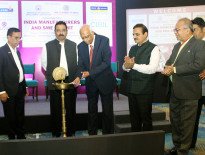Share

India’s push for manufacturing-led urbanisation aims to boost economic growth and living standards. The government has approved 12 new industrial parks under the National Industrial Corridor Development Program, focusing on sustainable infrastructure and job creation. This initiative is crucial as over 500 million people are expected to settle in urban areas. Urbanisation and manufacturing have gone hand in hand. In post-World War 2 Japan, Tokyo and Osaka became centres of industrial production. In China, Shenzhen and Guangzhou have become megacities. Urban areas often have skilled labour, crucial for industry. India has grappled with rapid and unplanned urbanisation that deviates from sustainable principles, leading to a decline in living standards. ‘Viksit Bharat’ hinges critically on manufacturing and urbanisation. India’s goal of becoming a high-income country will require growth rates of 8%+ in the next three decades, and a sustained increase in investment to about 35% of GDP. Only then will we see our per-capita incomes go from $2,000 to $18,000.
Manufacturing and infra development must lead this transition. Per-capita incomes are associated with labour productivity. To raise them, we must raise labour productivity. With close to 45% of our labour force in agriculture, with low productivity, our per-capita incomes are a fraction of those of other G20 nations. Manufacturing provides an avenue for large- scale employment, pulling labour out of agriculture. Manufacturing labour productivity stands at 3.5x that of agriculture, suggesting a significant increase in incomes if we can create enough jobs in manufacturing. For successful industrial development, it’s crucial to integrate quality infra that minimises ecological impacts and promotes energy efficiency and effective waste management. These elements should not only position industrial cities as economic hubs but also ensure they contribute to sustainable living environments. In this context, GoI’s recent approval of 12 new industrial parks under the National Industrial Corridor Development Program (NICDP) signifies a strategic leap in addressing the pivotal philosophies of manufacturing and urbanisation. These new nodes are designed to transform India’s industrial landscape and rectify short- sighted, unplanned urbanisation. With over 500 mn. people expected to settle in urban cities, the timing of this initiative is crucial. Embracing this manufacturing-led urbanisation model, the emphasis on creating industrial smart cities can make a difference for India as a manufacturing destination. By ensuring these areas are developed ‘ahead of demand’, GoI aims to build infra that anticipates future growth, thus avoiding pitfalls of hasty construction. The initiative’s key concepts include:
➤ Walk-to-work cities where residential areas integrate seamlessly with workplaces.
➤ Plug-and-play manufacturing allowing industries to start operations swiftly, enhancing efficiencies.
➤ Locating industries alongside residential settings, these parks can foster a better quality of life, reduce carbon footprints and enhance productivity.
➤ NICDP plans to create around 1 mn. direct and 3 mn. indirect jobs.
Emerging industrial cities act as catalysts to address urbanisation challenges directly. A prime example is Dholera Smart City, India’s first smart city. Integrating manufacturing with urban planning, Dholera is strategically designed to be twice the size of Delhi and six times that of Shanghai. Its infra plans boast remarkable connectivity through rail, road, express highways, an international airport and a metro system, linking the city to national and global markets. As seen in other townships like Shendra-Bidkin (Maharashtra), Integrated Industrial Township in Greater Noida (UP), and Integrated Industrial Township at Vikram Udyogpuri, Ujjain (MP), this approach drives economic growth while aligning urban development with community needs, creating livable cities for future generations. Despite the promise that these new industrial parks herald, the path ahead is challenging. Lessons from SEZs must inform the development of the new parks. Development of world- class, sustainable infra is imperative to India’s ambitions. NICDP aligns with the PM Gati Shakti National Master Plan, targeting multimodal connectivity that will enhance the movement of people, goods and services. With ready-to-allot land strategically located along with six major corridors, these industrial cities will not only draw domestic investments but also facilitate significant FDI. Outcomes of this initiative extend far beyond economic statistics. If executed effectively, it can lay the foundation for a cleaner, more equitable urban future.










